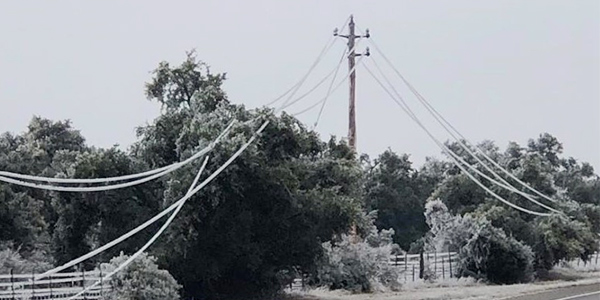
Akins said 2020 was a year of “tremendous challenges, the likes of which we have never seen, and it appears that 2021 has thus far had its own set of challenges.”
“A little over a month into the year, and we’ve experienced ice storms in the East and record cold temperatures in the West,” Akins said.
AEP Texas followed ERCOT: Grid was ‘Seconds and Minutes’ from Total Collapse.)
“During this event, our focus centered on responding to the directives from ERCOT to ensure that the flow of available power continued throughout this crisis. We also worked with our communities to identify critical load such as hospitals and other first responder resources in an effort to mitigate the impacts of key resources within our communities,” Akins said.
“This event serves as a sober reminder as to the critical nature of our nation’s energy supply and maintaining and supporting not only our economy, but also our fundamental way of life,” he added.
AEP Texas is a transmission and distribution utility in ERCOT, not a generator or a retail electric provider, Akins reminded shareholders. He said AEP expects little, “if any,” financial impact from the Texas event.
He said AEP load-shedding in SPP was minimal, but fuel costs were high during the storm. The company will seek alternative fuel cost recovery mechanisms to lessen ratepayer impacts.
Three AEP wind farms in the ERCOT region experienced cold weather outages Feb. 10, he said.
“We expect all three wind farms to be returned to full availability soon,” Akins said, emphasizing that the financial impacts from the wind outages would be immaterial.
Akins also said AEP’s Appalachian Power and Kentucky service territories sustained significant ice and tree damage to the transmission and distribution system in recent back-to-back storms. Restoration crews continue to make headway on the damage, and AEP intends to file for cost recovery of storm-related impacts, he said.
Call for Action
“These events, along with others around the country, have indicated the need for specific policy changes that focus on further refinements in reliability and resiliency of the grid,” Akins said. “Specifically, we would encourage more robust reliability assessments across electric, gas and other critical infrastructure classes determined where interdependencies exist and market designs that promote adequate capacity levels and increased generation reserve margins to provide a sufficient safety net during emergency situations.”
Akins called for winterization standards for power plants and natural gas delivery systems.
He said if “substantial” parts of the country are depending on natural gas, utilities should make sure plants and pipelines are able to perform under tight conditions. He also said better interregional transmission planning across RTOs’ seams and more DC ties into Texas can “enable regions to lean on each other in times of crisis.”
“All stakeholders must do better to address the issues that led us to these failures that have impacted so many customers at the worst possible time,” he said. “Whether it’s winter and summer weather event reliability or the speed at which the clean energy future can occur, AEP stands ready to be an active participant in resolving these issues, both from a state and national perspective.”
Akins predicted he would soon be testifying about the events. He said utilities should have greater insight into the “interaction and interoperability” of generation resources with distribution and transmission systems.
Akins said utilities need to make and announce clean energy decisions this year. He said AEP will propose in its integrated resource plan up to 330 MW of new renewable energy to serve Southwestern Electric Power Co. in the 2025-2028 time frame.
AEP has accelerated its carbon-reduction goals, targeting an 80% decrease from 2005 levels by 2030 and net-zero carbon emissions by 2050.
“I am reminded of one of my favorite movies, ‘Gladiator,’ in which Maximus Decimus Meridius says, ‘The time for half-measures and talk is over,’” Akins said. “It is time for serious execution by AEP to transform ourselves to embrace our clean energy future on behalf of and for our customers and communities.”
Earnings and Post-COVID Hopes
AEP earned $2.2 billion ($4.44/share) in 2020, compared with $1.9 billion ($3.89/share) a year earlier. The utility has upped its 2021 guidance to $4.55 to $4.75/share.
Profits were shaped by favorable taxes and investments and “certain regulatory outcomes that went our way,” Akins said.
However, Akins said AEP is disappointed in the outcome of Appalachian Power’s triennial rate case in Virginia, where state regulators in November denied the utility a rate increase.
AEP is seeking a rehearing and appeal of the decision with the Virginia Supreme Court.
“More to come on that,” Akins promised.
CFO Julie Sloat said load in AEP’s service territories generally fared better than other parts of the country because the areas had shorter and fewer economic shutdowns in response to the COVID-19 pandemic. The pandemic also provided opportunities for cost-cutting through inexpensive virtual training and travel reductions.
Sloat predicted the commercial and industrial sectors would steadily recover “as we migrate back to our post-pandemic lives” in 2021. She said load from schools, churches, restaurants and hotels is picking up, and overall load recovery “will likely track with vaccinations.”
Akins said he was optimistic about load recovery and growth in 2021. He said AEP load still trails pre-COVID levels but is improving. A push to harden grid infrastructure, especially following last week’s winter storm, should also bolster industrial load, he said.
Despite the obstacles of 2020 and early 2021, Akins predicted a promising year as the nation emerges from the pandemic. He paraphrased the lyrics to Johnny Nash’s “I Can See Clearly Now”: “I can see clearly now the rain has gone — and we can remove all obstacles in our way to a bright sunshiny day.”





